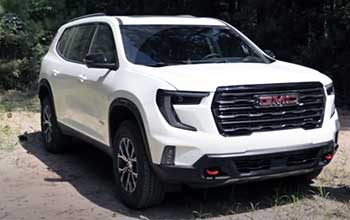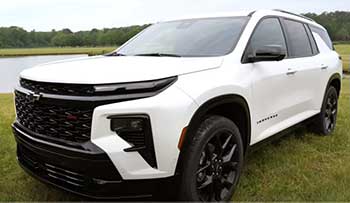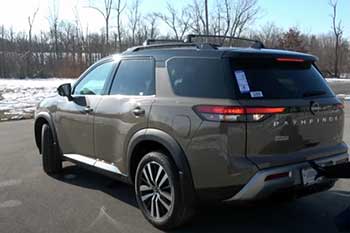
As a car enthusiast and parent, I’ve spent countless hours researching family-friendly SUVs, and the 2025 GMC Acadia and Nissan Pathfinder are two that caught my eye.
Both promise space, comfort, and versatility, but which one truly fits my lifestyle—or yours? In this article, I’ll share my firsthand insights, comparing their performance, features, and quirks to help you decide.
With a detailed breakdown of pros, cons, and practical tips, I aim to guide you through choosing the right three-row SUV for your adventures, whether it’s daily commutes or cross-country road trips.
Comparison Table
| Feature | 2025 GMC Acadia | 2025 Nissan Pathfinder |
|---|---|---|
| Starting MSRP | $42,995 | $36,080 |
| Engine | 2.5L Turbo I4, 328 hp, 326 lb-ft torque | 3.5L V6, 284 hp, 259 lb-ft torque |
| Fuel Economy (City/Hwy) | 22/27 MPG | 20/27 MPG |
| Cargo Space (Behind 3rd Row) | 23.0 cu. ft. | 16.6 cu. ft. |
| Max Towing Capacity | 5,000 lbs | 6,000 lbs |
| Passenger Space | 153.3 cu. ft. | 148.0 cu. ft. |
| NHTSA Safety Rating | 5 Stars | 5 Stars |
| Infotainment Screen | 15-inch touchscreen | 8-inch or 9-inch touchscreen |
| Standard Safety Features | Automatic emergency braking, lane keep assist | Automatic emergency braking, blind-spot monitoring |
| Warranty | 3 yr/36,000 mi comprehensive | 3 yr/36,000 mi comprehensive |
My Experience With The GMC Acadia
When I first slid into the driver’s seat of the 2025 GMC Acadia, it felt like stepping into a modern command center. The redesigned interior immediately grabbed my attention with its 15-inch touchscreen dominating the dashboard, giving it a futuristic vibe compared to older models.
Driving through city streets and open highways, the Acadia’s 2.5L turbocharged engine delivered a punchy 328 horsepower, making merges and passing effortless. Its ride was smooth, almost plush, absorbing bumps like a champ, which is a big deal when you’re hauling kids and gear.
The cabin space was a standout. With 153.3 cubic feet of passenger volume, my family of five had room to spare, even in the third row, where adults could sit without feeling cramped. Folding the second and third rows revealed a cavernous 97.5 cubic feet of cargo space—perfect for weekend camping trips or bulk shopping hauls.
The tech suite, including standard Apple CarPlay and Android Auto, kept everyone entertained, though I noticed the wireless charging pad was finicky with larger phones.
On the downside, the Acadia’s fuel economy, at 22 MPG city and 27 MPG highway, wasn’t class-leading, especially with gas prices creeping up. The higher starting price of $42,995 also gave me pause, especially compared to competitors.
Still, the premium feel of the Denali trim, with its leather seats and heated steering wheel, made it feel worth the splurge for those who value luxury.
I took the Acadia off-road on a gravel trail, and while the available all-wheel drive (AWD) and AT4 trim’s rugged tuning helped, it’s clear this SUV is more at home on pavement.
The nine-speed automatic transmission shifted smoothly, but I occasionally felt a slight lag in low-speed scenarios, like stop-and-go traffic. Overall, the Acadia impressed me with its blend of comfort and capability, but it’s not without flaws, which I’ll explore further.
Pros Of The GMC Acadia

- Spacious Interior: The Acadia’s 153.3 cubic feet of passenger space and 23 cubic feet behind the third row make it a haven for families or those needing extra room for gear.
- Powerful Engine: The 2.5L turbo I4 pumps out 328 horsepower, offering strong acceleration for highway driving or towing up to 5,000 pounds.
- Premium Features: Standard 15-inch touchscreen, wireless charging, and available Bose audio system elevate the cabin’s tech and comfort.
- Smooth Ride Quality: The suspension soaks up road imperfections, making long drives comfortable, even with a full load of passengers.
- Safety Suite: Standard features like automatic emergency braking, lane departure warning, and rear cross-traffic alert provide peace of mind.
- Upscale Design: The Denali trim’s leather upholstery and chrome accents give it a near-luxury feel without the luxury price tag.
- Service Network: With 54% more GMC dealers than Nissan, finding service or parts is easier, especially in rural areas.
The Acadia’s interior felt like a step above many competitors. I could stretch out in the front, and my kids didn’t complain about legroom in the back, which is a minor miracle. The powertrain’s torque made towing our small trailer a breeze, and the large touchscreen was intuitive, though it took a day to master the menus.
The safety features were a big win—lane keep assist gently nudged me back when I drifted during a long drive. However, the premium price tag means you’re paying for these perks, so budget-conscious buyers might hesitate.
Cons Of The GMC Acadia
- Higher Price Point: Starting at $42,995, the Acadia is pricier than the Pathfinder, which could strain budgets for cost-conscious buyers.
- Average Fuel Economy: At 22/27 MPG, it’s not the most efficient in its class, especially compared to hybrids like the Toyota Highlander.
- Limited Off-Road Capability: Despite the AT4 trim, the Acadia isn’t built for serious off-roading, lacking the ground clearance of true adventure SUVs.
- Smaller Towing Capacity: Maxing out at 5,000 pounds, it trails the Pathfinder’s 6,000-pound capacity, a drawback for heavy towing needs.
- Battery Power: The 660-amp battery is less robust than the Pathfinder’s 760-amp, potentially affecting reliability in extreme conditions.
- Infotainment Glitches: The large touchscreen occasionally lagged, and the wireless charging pad struggled with my oversized phone case.
- Third-Row Access: While spacious, getting to the third row requires some maneuvering, especially with car seats installed.
The Acadia’s price was a constant sticking point for me. I kept comparing it to the Pathfinder’s lower MSRP and wondering if the extra features justified the cost. Fuel stops added up on a road trip, and I wished for better mileage. Off-road, the Acadia handled light trails but felt out of its element on rougher terrain.
The infotainment system, while flashy, had moments of frustration when it froze during navigation. These quirks didn’t ruin the experience, but they made me question its value proposition for certain buyers.
Read more: My Thoughts on GMC Terrain Vs. Ford Escape.
Maintenance Tips For The GMC Acadia
- Regular Oil Changes: Use synthetic 5W-30 oil every 7,500 miles to keep the 2.5L turbo engine running smoothly; check the oil life monitor for precision.
- Tire Rotations: Rotate tires every 6,000-8,000 miles to ensure even wear, especially if you opt for AWD, which can stress tires unevenly.
- Brake Inspections: Check brake pads every 20,000 miles, as the Acadia’s weight can wear them faster, particularly in city driving.
- Air Filter Replacement: Swap the engine air filter every 15,000-20,000 miles to maintain fuel efficiency and engine performance.
- Coolant Flush: Flush the cooling system every 50,000 miles to prevent overheating, especially if you tow frequently.
- Battery Maintenance: Test the 660-amp battery annually, particularly in cold climates, to avoid starting issues; clean terminals to prevent corrosion.
- Software Updates: Visit a GMC dealer for infotainment system updates to fix glitches and improve touchscreen responsiveness.
Maintaining the Acadia isn’t overly complex, but staying proactive is key. I learned the hard way that skipping tire rotations led to uneven wear, costing me more at replacement time. The turbo engine demands quality oil, so I stick to synthetic and check the dipstick regularly.
Brake checks are crucial—city driving wore mine down faster than expected. The battery’s lower capacity worried me in winter, so I keep a portable charger handy. Dealer visits for software updates fixed some touchscreen lag, which was a relief. Following these steps keeps the Acadia reliable and ready for family adventures.
My Experience With The Nissan Pathfinder

Climbing into the 2025 Nissan Pathfinder, I was struck by its rugged, boxy redesign—a departure from the softer lines of older models. The 3.5L V6 engine, producing 284 horsepower, felt peppy enough for daily driving, though it lacked the Acadia’s turbocharged kick.
Navigating urban streets and winding country roads, the Pathfinder’s intelligent 4×4 system and seven drive modes gave me confidence, especially on a muddy trail where it outperformed the Acadia off-road.
The interior, with 148 cubic feet of passenger space, was roomy but noticeably tighter in the third row compared to the Acadia. Cargo space behind the third row, at 16.6 cubic feet, was adequate for groceries but cramped for larger loads.
The standard 8-inch touchscreen (upgradable to 9 inches) was user-friendly, and ProPilot Assist, Nissan’s semi-autonomous driving tech, made highway cruising a breeze. However, the lack of a heated steering wheel on lower trims was a letdown in chilly weather.
Towing was a strong suit, with a 6,000-pound capacity that easily handled my boat trailer. Fuel economy, at 20/27 MPG, was on par with the Acadia but not stellar.
The Pathfinder’s lower starting price of $36,080 made it feel like a better value, though its interior materials felt less premium. Quirky issues, like a creaky dashboard on my test model, reminded me of reliability concerns from past Nissans, but overall, it’s a solid contender.
Pros Of The Nissan Pathfinder
- Lower Starting Price: At $36,080, it’s significantly cheaper than the Acadia, making it a budget-friendly option for families.
- Superior Towing Capacity: With a 6,000-pound max towing capacity, it outshines the Acadia for hauling trailers or boats.
- Off-Road Capability: The intelligent 4×4 system and seven terrain modes make it more adept for light off-road adventures.
- Advanced Safety Tech: ProPilot Assist and standard blind-spot monitoring offer cutting-edge driver assistance features.
- Flexible Seating: Second-row captain’s chairs or bench options accommodate up to eight passengers, ideal for larger families.
- Reliable Battery: The 760-amp battery provides better cold-weather starting power than the Acadia’s 660-amp unit.
- Top Safety Ratings: Earned a 2023 IIHS Top Safety Pick+ for superior crash test performance.
The Pathfinder’s affordability was a game-changer for me. I could get a well-equipped model without breaking the bank, and towing my trailer was stress-free. The off-road modes were fun to test on a weekend trip, handling gravel and mud better than I expected. ProPilot Assist made long drives less taxing, and the safety suite gave me confidence with kids in tow. The interior, while not as plush as the Acadia, was practical and easy to clean—a must for parents. It’s a versatile SUV that punches above its price point.
Also read: My Thoughts on Ford Edge Vs. Hyundai Tucson.
Cons Of The Nissan Pathfinder
- Tight Third Row: With only 29.7 inches of legroom, the third row feels cramped for adults on longer trips.
- Less Cargo Space: 16.6 cubic feet behind the third row limits storage compared to the Acadia’s 23 cubic feet.
- Lower Horsepower: The 3.5L V6’s 284 horsepower feels adequate but lacks the Acadia’s punch for quick acceleration.
- Basic Interior Materials: Plastic-heavy cabin and fewer premium touches make it feel less upscale than the Acadia.
- Fuel Economy: At 20/27 MPG, it’s not a standout in efficiency, especially with premium fuel required for some trims.
- Reliability Concerns: Past models had quirky issues, and my test unit’s dashboard creaks raised red flags.
- Smaller Dealer Network: Fewer Nissan dealers compared to GMC can make servicing less convenient.
The Pathfinder’s third row was a squeeze for my taller friends, and packing for a family trip required creative Tetris skills due to the smaller cargo area. The V6 engine, while reliable, didn’t thrill me like the Acadia’s turbo.
I noticed cheaper plastics in the cabin, which dulled the experience compared to the Acadia’s upscale vibe. Fuel costs added up, and the premium fuel requirement for the Rock Creek trim annoyed me. The creaky dashboard made me question long-term durability, though Nissan’s warranty eased some concerns.
Maintenance Tips For The Nissan Pathfinder
- Oil Changes: Use 0W-20 synthetic oil every 5,000-7,500 miles to keep the V6 engine in top shape; monitor oil levels monthly.
- Tire Maintenance: Rotate tires every 7,500 miles and check alignment annually, especially with 4×4 models to prevent uneven wear.
- Brake System: Inspect brake pads every 15,000 miles, as towing heavy loads can accelerate wear.
- Air Filter: Replace the engine air filter every 20,000 miles to optimize fuel economy and engine performance.
- Coolant Check: Flush the cooling system every 60,000 miles to avoid engine overheating, particularly in hot climates.
- Battery Care: Test the 760-amp battery every year, cleaning terminals to ensure reliable starts in all conditions.
- Transmission Service: Check the nine-speed automatic transmission fluid every 30,000 miles to maintain smooth shifts.
The Pathfinder’s maintenance is straightforward, but I found sticking to a schedule crucial. I changed the oil religiously after a friend’s V6 engine suffered from neglect. Tire rotations kept my 4×4 model’s handling crisp, especially after off-road trips.
The brakes needed checking after towing, as they wore faster than expected. The air filter swap improved gas mileage slightly, which was a relief. Battery maintenance was a non-issue thanks to the robust 760-amp unit. Keeping the transmission fluid fresh prevented any shift lag, making the Pathfinder a dependable ride.
Comparison With Other Brands
- Toyota Highlander: Offers better fuel economy (up to 36 MPG in hybrid form) but less towing capacity (5,000 lbs) and a smaller third row than the Acadia.
- Honda Pilot: Matches the Pathfinder’s off-road capability with similar cargo space but has a more refined interior and slightly better reliability ratings.
- Kia Telluride: Boasts a luxurious interior rivaling the Acadia’s Denali trim, with a 5,000-pound towing capacity and top safety scores, but it’s pricier.
- Ford Explorer: Provides more horsepower (up to 400 hp) and comparable towing to the Pathfinder, but its third row is cramped, and reliability is spotty.
- Mazda CX-90: Delivers a premium driving experience and better fuel economy than both, but its cargo space (14.9 cu. ft.) trails the Acadia significantly.
The Highlander’s hybrid option tempted me for its efficiency, but its towing limit was a dealbreaker. The Pilot felt like a middle ground, with a nice balance of space and reliability, though it lacked the Acadia’s upscale flair.
The Telluride’s interior was gorgeous, but its price crept close to the Acadia’s without matching its cargo capacity. The Explorer’s power was fun, but I heard mixed reviews on durability. The CX-90 drove like a dream, but its tight cargo area didn’t suit my family’s needs. Both the Acadia and Pathfinder hold their own, but your priorities will dictate the winner.
Frequently Asked Questions (FAQ)
Yes, the Acadia is larger, offering 153.3 cubic feet of passenger space and 23 cubic feet of cargo behind the third row, compared to the Pathfinder’s 148 cubic feet and 16.6 cubic feet.
The Pathfinder has a cramped third row, limited cargo space, lower horsepower, and less premium interior materials compared to the Acadia, with some reliability concerns from past models.
The Acadia is generally reliable, with an iSeeCars rating of 8.4/10, though it trails the Pathfinder’s 8.6/10. Regular maintenance is key to long-term dependability.
The Acadia is comparable to the Chevrolet Traverse, Buick Enclave, and Nissan Pathfinder, offering similar three-row seating and midsize SUV versatility with a more upscale design.
Conclusion: For GMC Acadia And Nissan Pathfinder
Choosing between the 2025 GMC Acadia and Nissan Pathfinder depends on what you value most. If you crave a spacious, premium SUV with a powerful engine and high-end features, the Acadia’s roomy interior and sleek tech make it a fantastic pick, though its higher price and average fuel economy might give you pause.
If budget and towing are your priorities, the Pathfinder’s lower cost and 6,000-pound towing capacity are hard to beat, despite its tighter third row and less luxurious cabin. Test drive both to see which fits your lifestyle—you won’t be disappointed either way.

